Saraye Moshir - Shiraz’s Traditional Marketplace
Saraye Moshir, also known as Moshir Arcade, is a traditional Bazaar in Shiraz built during the Qajar era in the 19th century and located near the famous Vakil Bazaar.
It dates back over 250 years and was originally founded by Mirza Abolhassan Moshir-ol-Molk, the governor of Fars province, and served as a major center for trade and as a caravanserai along the Silk Road.
Over time, the caravanserai has served many purposes including a museum, a tea house and an exhibition space known as Saraye Honar (Art House), where local artisans display their traditional handicrafts.
If you're on one of our Shiraz tours and planning to see Meshkinfam house, this article is for you!
Join us to learn everything you need to know about this enchanting bazaar!
About Saraye Moshir

The term "bazaar" is ancient, originating from the Persian language, and signifies a place for buying and selling goods. This word spread to various regions that traded with Iran, including Arabic, Turkish, Ottoman, and some European territories.
In Persian, the term has always referred to a trading space, with many cities having their own distinct bazaars for local goods. Depending on the size and location, these bazaars varied in their scope of trade.
Saraye Moshir, also known as Golshan Caravanserai, is one of the most significant historic bazaars in Shiraz, dating back to the Qajar era. Located in the southeastern section of Vakil Bazaar, it was restored in 1967 and remains a prominent attraction for visitors.
Saraye Moshir is often mistaken for Vakil Bazaar due to its architectural similarities, but it has its own unique identity. It features a hexagonal structure, connecting the older bazaar with the newer Moshir bazaar, known for its serene atmosphere.
Architecturally, Saraye Moshir consists of a two-part northern and southern structure, linked by a large dome-covered intersection known as the Chahar-Suq, which is crowned with a wind tower to provide ventilation.
The northern section has six pairs of shops, one leading into the caravanserai itself. The southern part of the bazaar connects through a passage to Ardou Bazaar, with intricately decorated tile work at its entrance.
The bazaar’s beautiful courtyard is lined with shops and artisanal booths, offering a variety of local handicrafts. Visitors can also admire the market’s decorative entrance, featuring stunning tile mosaics and inscriptions detailing the building’s history and its endowment.
History of Saraye Moshir
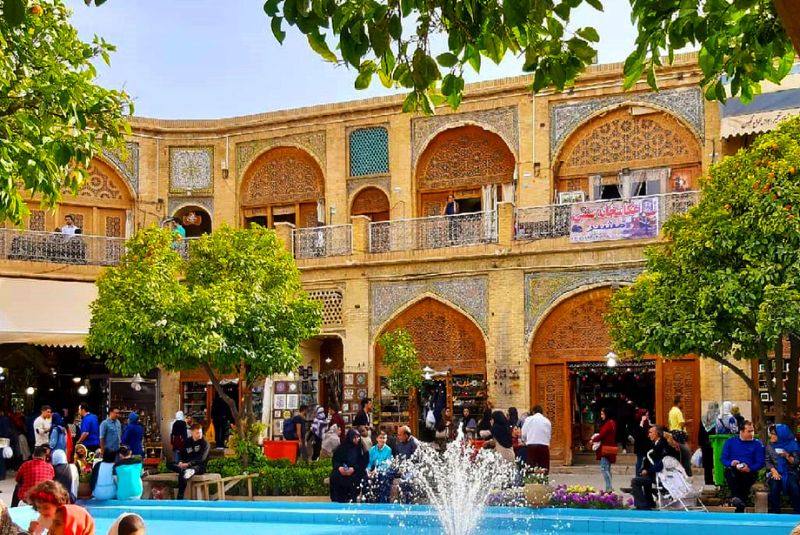
Saraye Moshir, also known as Golshan Caravanserai, dates back to the Qajar era during the reign of Fath Ali Shah. It was commissioned by Mirza Abolhassan Khan Moshir-ol-Molk, the then minister of Fars Province, and built in the southern part of the famous Vakil Bazaar.
According to inscriptions and historical records, the caravanserai was endowed to the fifth Shia Imam, as detailed in the endowment inscription displayed at the main entrance of Saraye Moshir.
Over the years, Saraye Moshir experienced significant aging, and by the Pahlavi era, it had fallen into disrepair. In 1969, under the direction of Farah Diba, the complex was restored and renovated.
During this restoration, the central courtyard was transformed into a teahouse, and the rooms were repurposed to showcase local arts and crafts of Fars Province. Since then, Saraye Moshir has also been known as "Sarayeh Honar" or "Art House."
Registered as a national heritage site in 1968, Saraye Moshir remains a valuable cultural landmark. Today, the shops within the caravanserai are managed by the Hajj and Endowments Organization and are rented out to various businesses, preserving its historical essence while serving modern functions.
| Read more: Shiraz Tourist Attractions
Architecture of Saraye Moshir
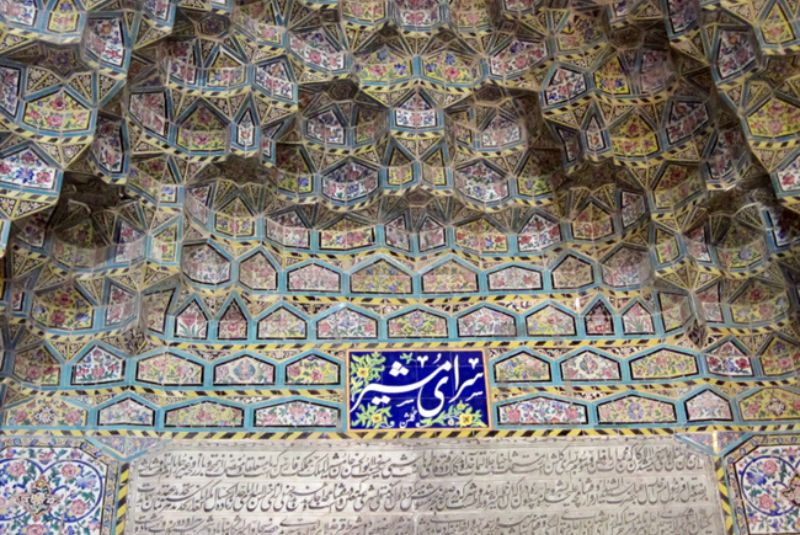
Upon entering Saraye Moshir for the first time, you might find it challenging to distinguish it from the adjacent Vakil Bazaar due to their similar architectural styles. However, what sets Saraye Moshir apart is its distinctive courtyard, centrally positioned within the structure.
This courtyard features a central pond and elegant orange trees, creating a picturesque focal point. The entrance hall, or "hashti," divides the market into two sections, connecting the northern side to Saraye Moshir and the southern side to the Urdu Bazaar.
Design and Structure
The Urdu Bazaar, which extends southeast from Vakil Bazaar, is characterized by its winding pathways and a roof covered with tin and wooden arches, some of which show signs of burning. This market, along with the Copper Market and the Poultry Market, forms a triangular configuration with its apex located in the southern part of Vakil Bazaar.
A large wooden door leads into the entrance hall of Saraye Moshir, which connects the market to the newer section. The entrance hall boasts a high ceiling, topped with a relatively large, low dome and a multi-faceted wind catcher.
The architects have adorned the market with beautiful tile work, intricate wooden carvings, and stained glass, reflecting the renowned Iranian traditional architectural style. Even the central pond is enhanced with unique tile and stucco decorations, showcasing the skill of Iranian artisans.
Historical Details
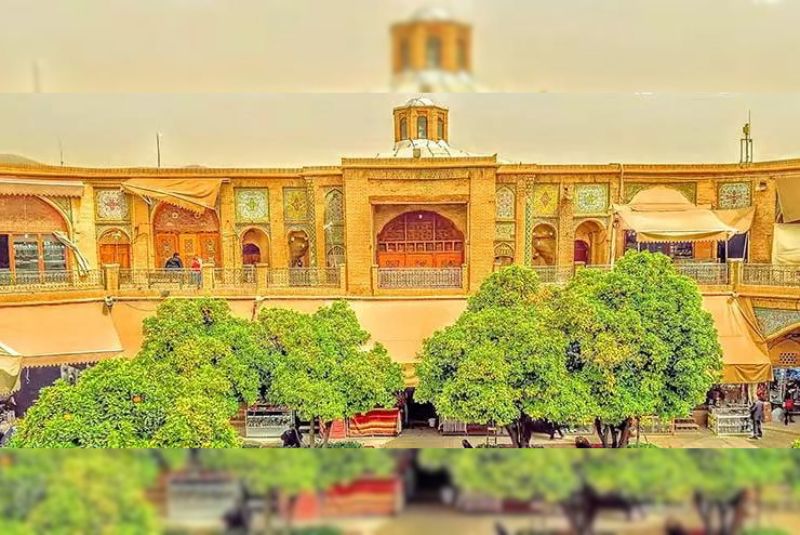
Above the main entrance of Saraye Moshir, a stone slab displays the endowment inscription, dating back to Ramadan 1288. The entrance arch is decorated with tile work and stucco, while the surrounding hallway features mosaic tiles.
The market's four sides include two-story chambers, with vaulted ceilings constructed without wooden beams—a notable architectural feature. The southern entrance features tiled decorations and an inscription commemorating its completion in 1371 AH, funded by "the late Sultan al-Hajiyeh and Moadel al-Molk." The area also includes a stone-paved corridor, adding to its historical charm.
| Suggestion: History of Iran
Saraye Moshir Significance

Saraye Moshir is a historical gem renowned for its traditional architecture and vibrant bazaar atmosphere. It stands out for its beautiful courtyard, intricate tilework, and diverse range of handicrafts.
Its significance extends beyond commerce, serving as a cultural hub where visitors can experience local art, enjoy Shiraz’s famous sweets, and appreciate the city's rich heritage.
Things to Do at Saraye Moshir
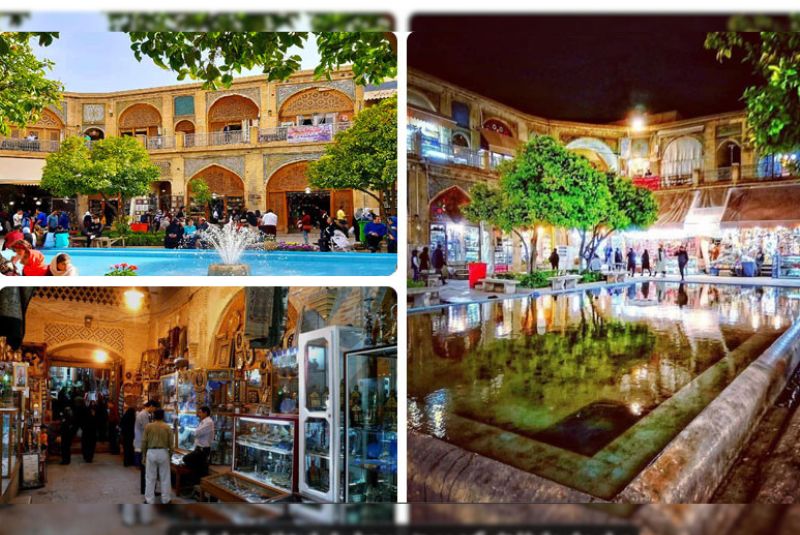
Explore Handicrafts and Souvenirs
Saraye Moshir is a very Old Bazaar of Shiraz City offering a unique shopping experience distinct from Vakil Bazaar. Here, you can find a variety of traditional Persian handicrafts, including Khatam Kari (inlaid work), Moaragh Kari (marquetry), and intricate engravings on gold and copper. Souvenirs such as miniature statues of Shiraz's famous attractions and notable figures are also available, making it a great spot for finding memorable gifts.
Savor Local Delights
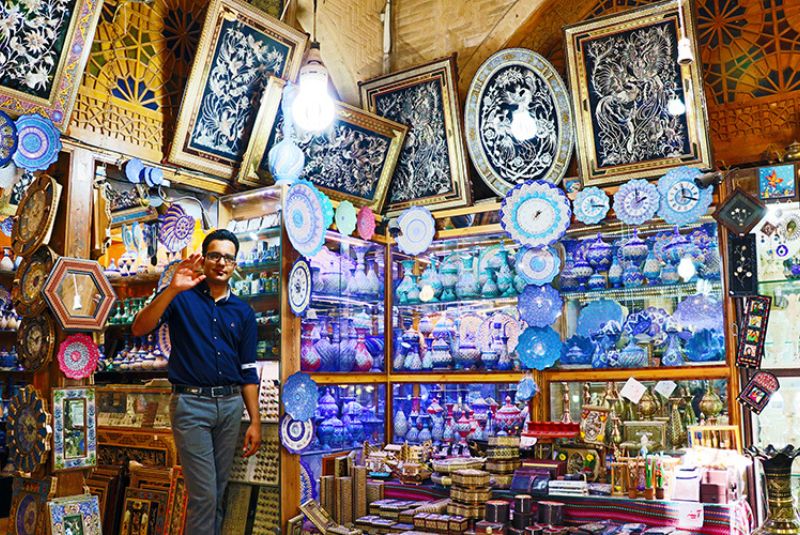
Don’t miss the chance to enjoy Shiraz’s famous Faloodeh (a cool, refreshing dessert) and ice cream while visiting Saraye Moshir. The bazaar’s central pool area provides a perfect setting for savoring these treats. A cup of Persian tea can also be enjoyed here, enhancing the experience with a taste of local flavors.
Meet the Guardian
If you’re lucky, you might encounter the guardian of Saraye Moshir. Known for his charming demeanor and traditional attire, he’s a delightful character to meet. Feel free to ask him for a photo opportunity to remember your visit.
Relax and Enjoy the Atmosphere
Even if you’re not interested in shopping or history, taking a moment to relax by the central pool and watch the vibrant activity around you can be a pleasant experience. The bazaar’s picturesque setting and the refreshing ambiance of the pool offer a serene escape from the bustle of the city.
Discover Local Artisans
Saraye Moshir is renowned for its artisan workshops. Watch craftsmen engage in traditional arts like Khatam Kari, marquetry, engraving, and rug weaving. These artisanal activities provide insight into the rich cultural heritage of the region.
Saraye Moshir Location and Access
Saraye Moshir, one of Shiraz’s top tourist attractions, is located at the intersection of Lotf Ali Khan Zand Street and Taleghani Street, near the famous Vakil Bazaar. Its strategic location places it on the well-trodden path connecting the Shah Cheragh Shrine with Vakil Bazaar, mosque, and bathhouse. With its central position, it’s easy to find on any city map once you reach Shiraz.
How to Get to Saraye Moshir
- By Car: Head to Shohada Square and Namazi Intersection. From there, follow Lotf Ali Khan Zand Street and then turn onto Taleghani Street, where several parking lots are available.
- By Bus: This area is among the busiest in the city, with multiple bus stations nearby, including Shahrdari Station, making public transport an easy option.
If you prefer walking, the distance from Shah Cheragh Shrine is quite manageable, offering a pleasant stroll through historic Shiraz.
Opening Hours
Saraye Moshir, one of Shiraz's most beautiful historical sites built during the Qajar era, is open to visitors from approximately 9 AM to 9 PM. Please note that the bazaar is closed on Fridays and official holidays.
Ticket Price
Entry to Saraye Moshir is free, allowing visitors to enjoy the exquisite details of Iranian architecture without any cost.
Tourist Attractions Near Saraye Moshir
Vakil Bazaar
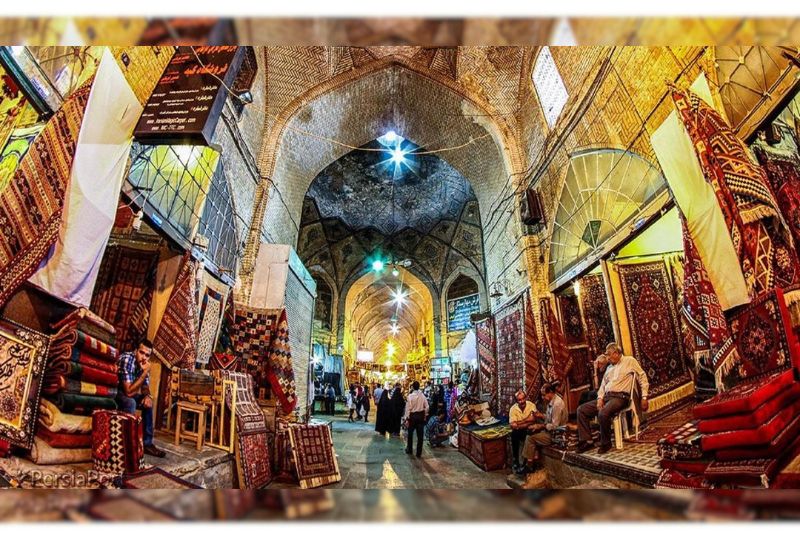
Vakil Bazaar, located in the heart of Shiraz, is one of Iran’s oldest and most vibrant markets. Constructed during the Zand dynasty, this historic bazaar features over 1,000 shops and workshops.
It offers a diverse range of products, including carpets, rose water, perfumes, clothing, jewelry, pottery, enamelware, and woodcraft. The bazaar's architecture is a fine example of traditional Iranian design, adapted to Shiraz’s hot and dry climate.
Within the bazaar, you’ll find notable structures such as Saraye Moshir, Vakil Bath, Vakil Mosque, and Timcheh-ye Atarin. Each section of the bazaar, including its arcades and alleys, is named after the goods sold there, adding to its charm and historical significance.
Khan School
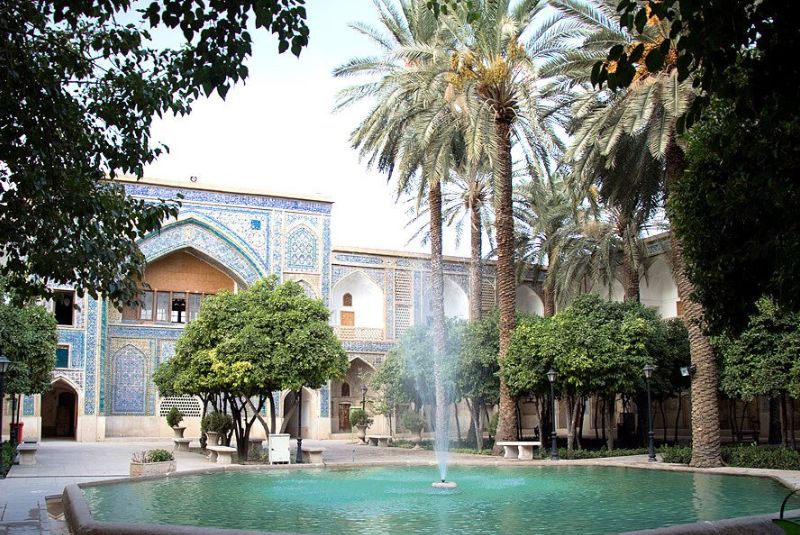
Khan School, built during the Zand dynasty, is one of Shiraz’s oldest and most renowned educational institutions. Located in the Sang-e-Siah neighborhood, the school is celebrated for its beautiful and unique architecture. It includes two gardens and two water pools, creating a tranquil and refreshing environment.
Khan School also houses a significant library with a collection of rare and valuable books, making it a valuable site for those interested in Iranian history and literature.
Pars Museum (Bagh-e-Nazar)
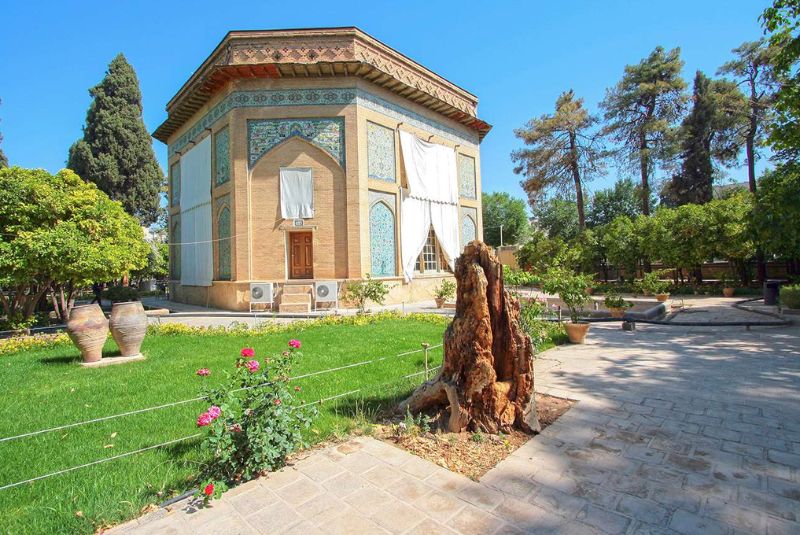
Pars Museum, situated in the historic Bagh-e-Nazar, is a major cultural and historical attraction in Shiraz. The museum, housed in one of the Qajar period gardens, features several sections: archaeology, numismatics, contemporary history, Islamic art, modern art, and a library and archive.
Each section showcases valuable artifacts and objects that illustrate Iran’s diverse cultural and historical heritage, making it an essential destination for history and culture enthusiasts.
Karim Khan Fortress
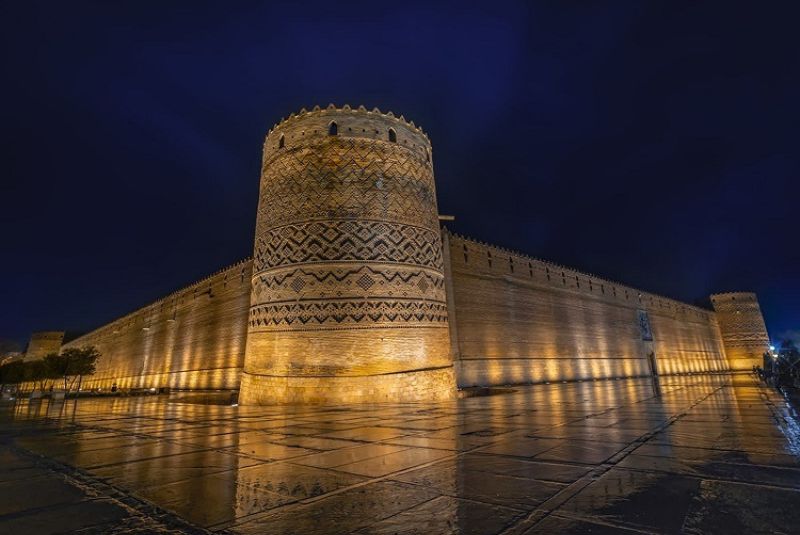
The Arg of Karim Khan is a notable historical and architectural landmark in Shiraz, constructed during the Zand dynasty. Located in the city center, the fortress features four rectangular towers, one of which served as a clock tower.
It was built as the residence and government seat for Karim Khan Zand and later used by some Qajar kings. The fortress is designed in traditional Iranian traditional style, with an inner courtyard, large rooms, a bathhouse, mosque, and museum, making it a popular attraction for visitors.
Shah Cheragh Mosque
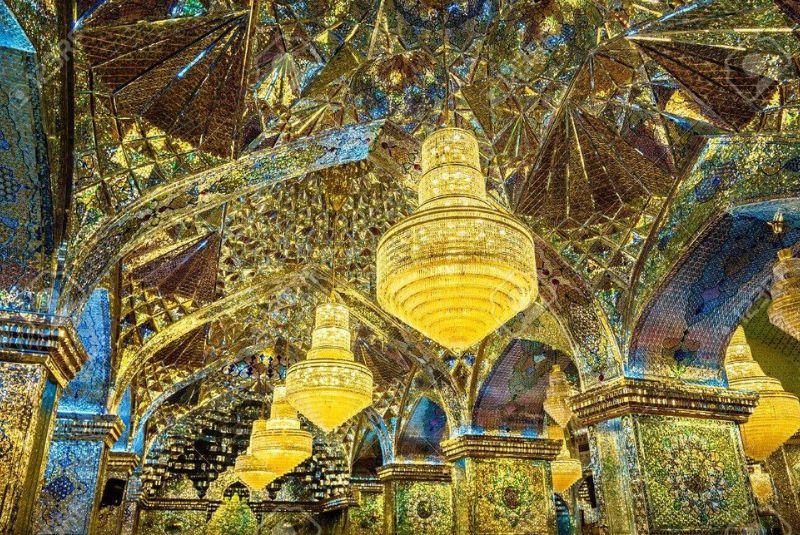
Shah Cheragh Mosque is one of the most beautiful and significant architectural and historical sites in Iran. Located in the heart of Shiraz, the mosque is renowned for its stunning decorations, including colorful glass and mirrors.
Built in 653 AH by the brothers of Imam Reza (AS), Ahmad bin Musa and Muhammad bin Musa, who are revered as Shah Cheragh and Sahib al-Noor respectively, the mosque houses their sacred remains. This mosque is a vital pilgrimage site and a testament to Shiraz’s rich religious heritage.
Where to Eat Near Saraye Moshir
After a visit to Saraye Moshir, you can enjoy Persian cuisine at these nearby restaurants: Kate Mast Traditional Restaurant, Sharze Restaurant, Dash Akol Traditional Restaurant, and Saraye Mehr Traditional Restaurant.
| Related: Best Restaurants in Shiraz
Where to Stay Near Saraye Moshir
For convenient lodging close to Saraye Moshir, consider staying at Parmis Hotel, Park Hotel, Hafez Hotel, or Sasan Hotel. Each offers comfortable accommodations and easy access to the historic site.
| Related: Best Hotels in Shiraz
Bottom Line
Saraye Moshir offers a unique glimpse into Shiraz’s rich history and exquisite Qajar-era architecture. This charming bazaar, with its vibrant shops and traditional craftsmanship, provides a wonderful backdrop for exploring local art and enjoying Persian cuisine.
Whether you're admiring the intricate tilework or relaxing by the central pool, Saraye Moshir is a must-visit for anyone exploring Shiraz. Its convenient location near other historic sites makes it a perfect addition to your travel itinerary.
Share your story!
Comment below and let us know about your Experience.
Your story inspires others!


Comment
Leave a Comment